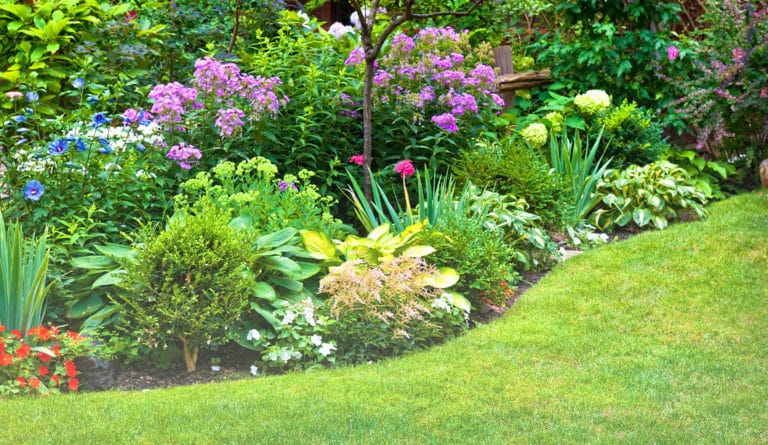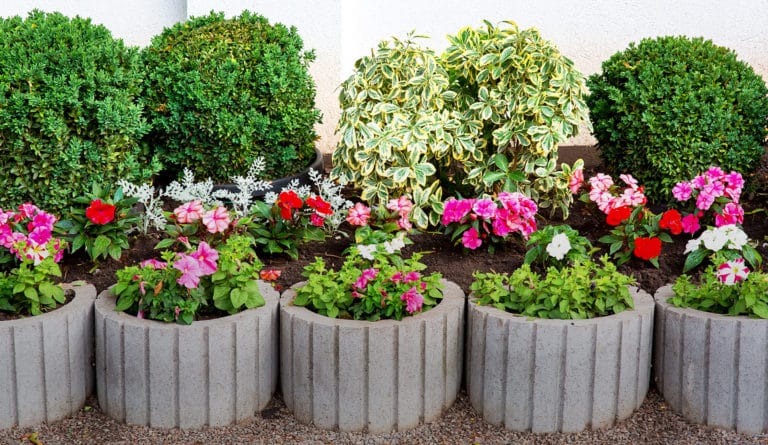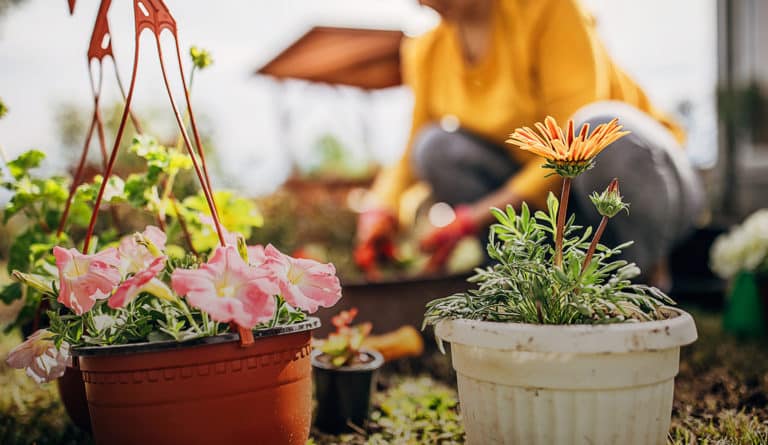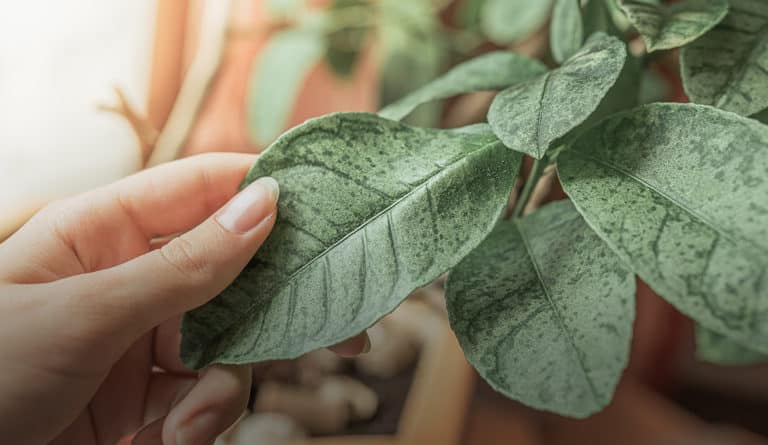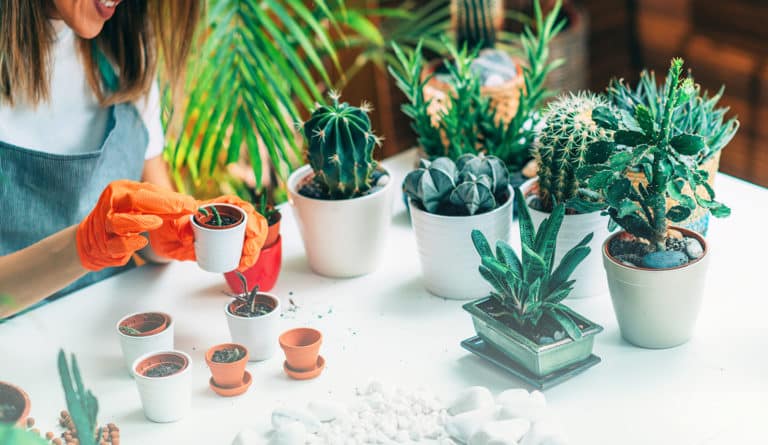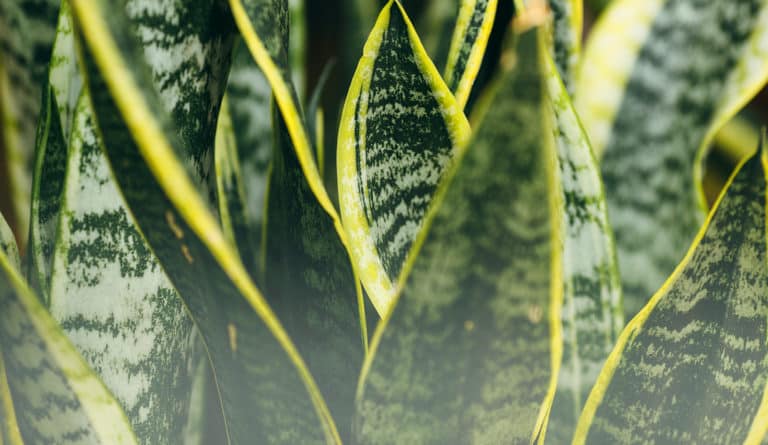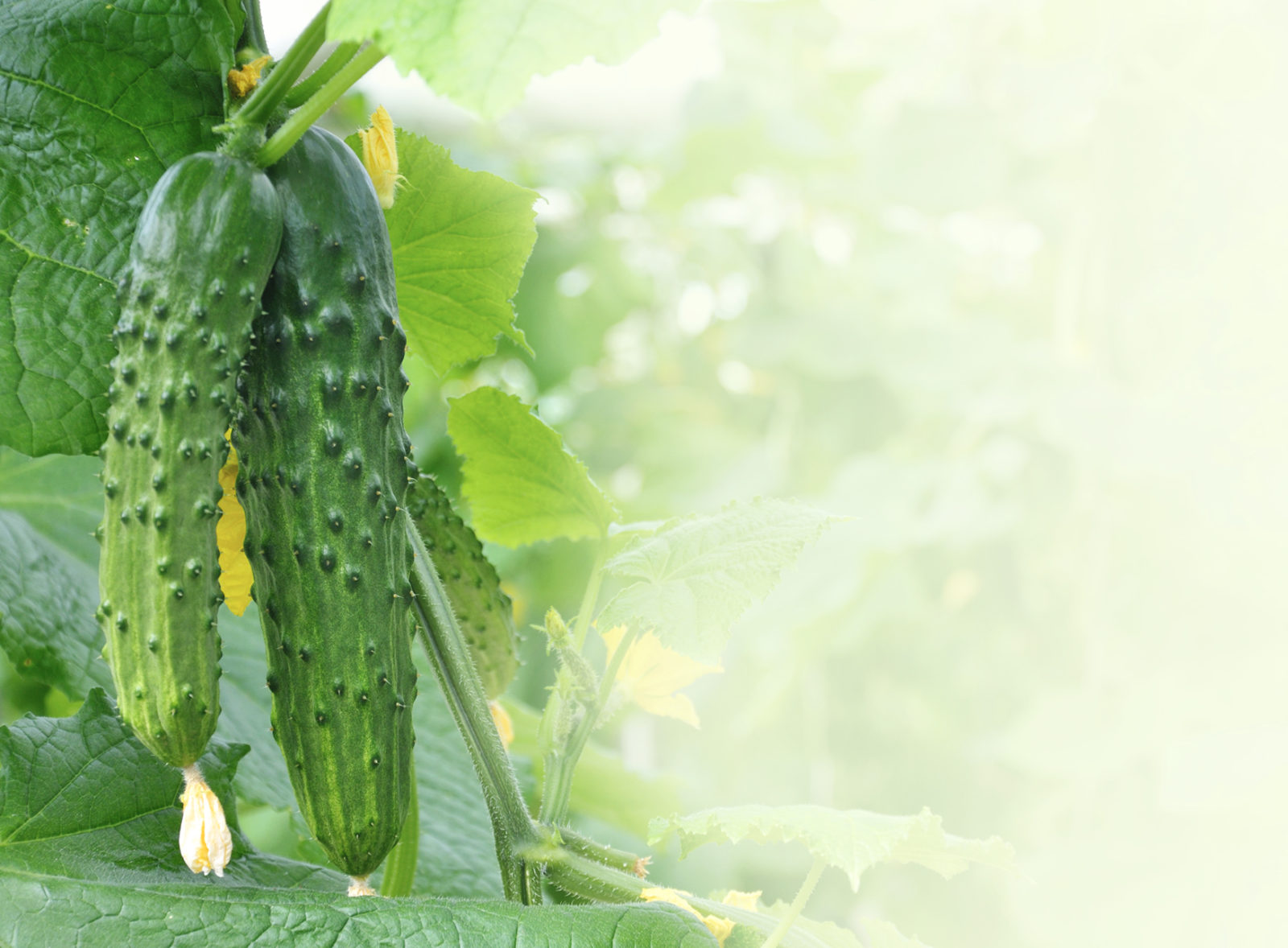
cucumbers
aka Cucumis Sativus
Crunch! Cucumbers are delicious in salads, and the perfect gateway to your new obsession with pickling. Their vines want to run wild, but they are trainable.
variations
Armenian Cucumber, English Cucumbers, Lemon Cucumbers and Persian Cucumbers, and almost 100 more varieties!
light
full sun
Cucumbers like about 8 hours of sunlight a day.
water + feeding
thirsty friends
The thirsty vines of the Cucumber need at least 1 inch of water per week. And if your cucumbers are out in full sun, get ready to water a lot!
toxic
non-toxic
Cucumbers are non-toxic and even make delicious, hydrating snacks for cats and dogs.
size
medium
Smaller cucumber varieties are best grown to about 4 inches (10 cm). Longer varieties like English cucumbers can grow 6 to 8 inches (15–20cm). General rule, smaller is better. Don’t let them overgrow or they may get soft and bitter.
pro tip
oh shoot!
When a vine has grown 7 leaves, pinch off the growing tip. The vine should develop side shoots that you can leave on the ground, or train up a trellis or netting.
fun fact
super hydrater
Raw cucumbers are 95% water! They’re also 100% delicious.
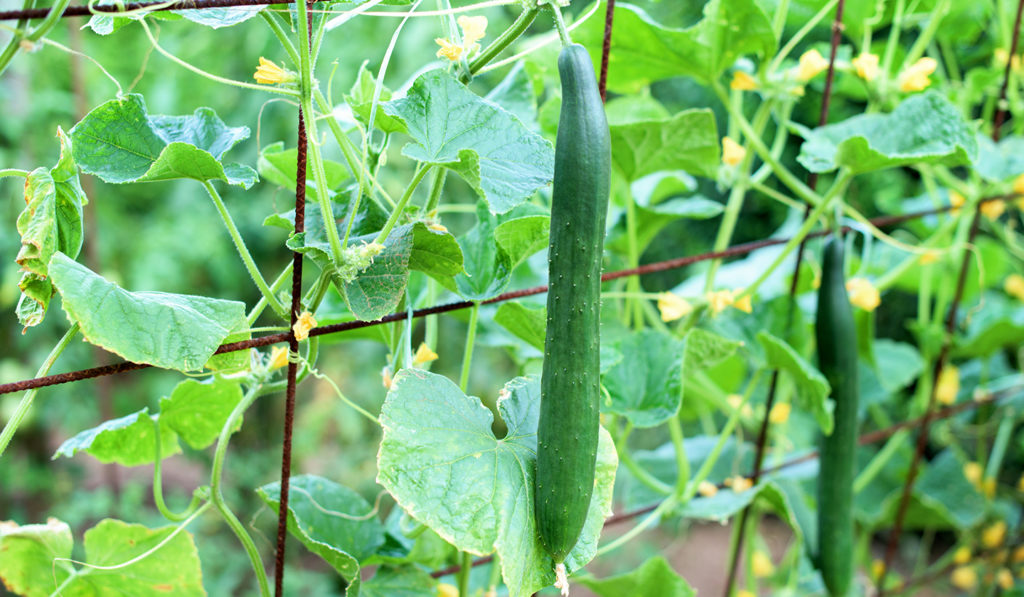
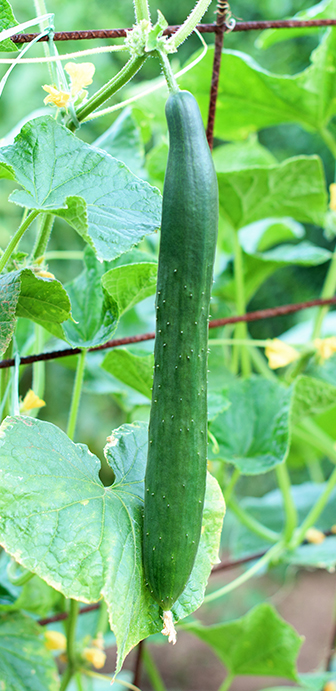
beyond the basics
-
soil & potting
Cucumbers need warm soil to germinate. Find a spot with good light and well–draining soil. Plant seeds in mounds about 1 inch deep. Give that little seed or container seedling lots of space, once they get growing, their vines really spread out to boost growth, feed the soil with dolomite lime, compost or Miracle-Gro® Shake ‘n Feed Tomato, Fruit & Vegetable Plant Food.
-
companion planting
Cucumbers work well beside asparagus, beans, Brassicas, celery, corn, dill, kohlrabi, lettuce, onion, peas, radish, and tomatoes. Avoid potatoes and sage. Sunflowers and cornflowers make a beautiful natural trellis for cucumber vines to climb. Dill attracting beneficial predatory insects that eat pests. The nasturtium flower repels pests and is even thought to improve a cucumber’s taste.
-
harvesting
Harvest time! Your cucumbers should be uniformly green, firm, and have a slightly rounded tip. They grow rapidly, so check them often. Be sure you don’t miss any under the leaves. Once they become yellow, bulbous or soft, they’re overripe. A little early is better than too late.
-
pest control
What are these little white flies? They are literally Whiteflies. They drink sap and excrete a sticky ‘honeydew’ which also encourages mould. Use sticky traps or Ortho® Bug B Gon® ECO Insecticidal Soap to keep your cucumbers healthy. Another common pest is the cucumber beetle. These little guys can be found on your seedlings, just as they’re starting to grow up. If you don’t catch these beetles soon enough, their larvae will feed on the plant and kill it. Cucumber beetles also spread bacteria and viruses when they move from plant to plant. To get rid of these little pests, try using sticky traps. You could also knock the beetles off your plant and catch them in a little piece of cardboard or a small jug.
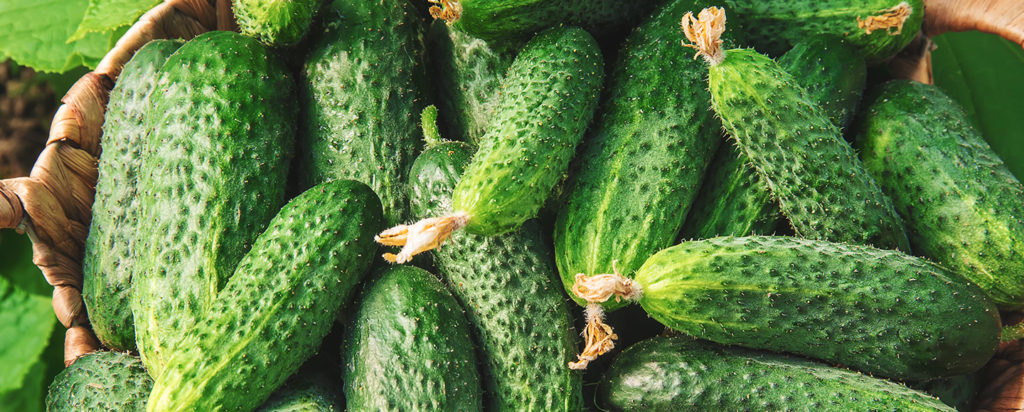
troubleshooting
-
what ate my stems right near the soil level?
Probably Cutworms. Check the soil for gray grubs about 1/2 inch (1 cm). They love to eat stems, roots, and leaves. Protect your vines with a 3 inch paper collar around the base. You can also sprinkle wood ash around the base. It helps to keep your garden weed free.
-
drooping or wilting leaves?
Needs water. Does your Pothos look wilted and droopy? Do those normally perky heart-shaeped leaves feel thinner? Your poor Pothos is crying out for a drink. Instead of doing one giant dump of water, water a little once per day for three days. You want the soil pleasantly moist, not super soggy. Your Pothos should bounce back in just a few days.
-
why do I have deformed or yellow leaves?
Likely Aphids. Look for teeny-tiny oval, and yellowish– green pear-shaped insects, clustering under the leaves. They excrete a sticky waste called honeydew (far too pleasant a name) which turns into black powdery mold. Treat with insecticidal soap.
-
why are my smaller plants turning yellow?
Sounds like Southern corn rootworm. They’re the larval form of the spotted cucumber beetle. Turn over the soil in your garden to interrupt this pest’s destructive life cycle.
-
what’s this white, powdery stuff?
It’s a fungus called Powdery Mildew. It forms white spots on the leaves or even the stems. Left un-checked it can turn the leaves yellow or even brown. Lack of airflow is the cause, so do what you can to clear around your plants. Remove infected leaves. To fight the mildew, your garden centre will have a spray containing sulfur.
-
no fruit coming through?
It’s a plant sex thing. A cucumber’s first flowers are male, followed by female flowers. Only the female flowers produce cucumbers, so you may just need to wait a bit, until the female flowers get pollinated. If there aren’t enough pollinators (like bees) in your area, you can plant flowers in your garden to attract them. Or, be the bee! Pick some male flowers and dust their pollen on the female flowers.

cucumbers
aka Cucumis Sativus
Crunch! Cucumbers are delicious in salads, and the perfect gateway to your new obsession with pickling. Their vines want to run wild, but they are trainable.
variations
Armenian Cucumber, English Cucumbers, Lemon Cucumbers and Persian Cucumbers, and almost 100 more varieties!
light
full sun
Cucumbers like about 8 hours of sunlight a day.
water + feeding
thirsty friends
The thirsty vines of the Cucumber need at least 1 inch of water per week. And if your cucumbers are out in full sun, get ready to water a lot!
toxic
non-toxic
Cucumbers are non-toxic and even make delicious, hydrating snacks for cats and dogs.
size
medium
Smaller cucumber varieties are best grown to about 4 inches (10 cm). Longer varieties like English cucumbers can grow 6 to 8 inches (15–20cm). General rule, smaller is better. Don’t let them overgrow or they may get soft and bitter.
pro tip
oh shoot!
When a vine has grown 7 leaves, pinch off the growing tip. The vine should develop side shoots that you can leave on the ground, or train up a trellis or netting.
fun fact
super hydrater
Raw cucumbers are 95% water! They’re also 100% delicious.
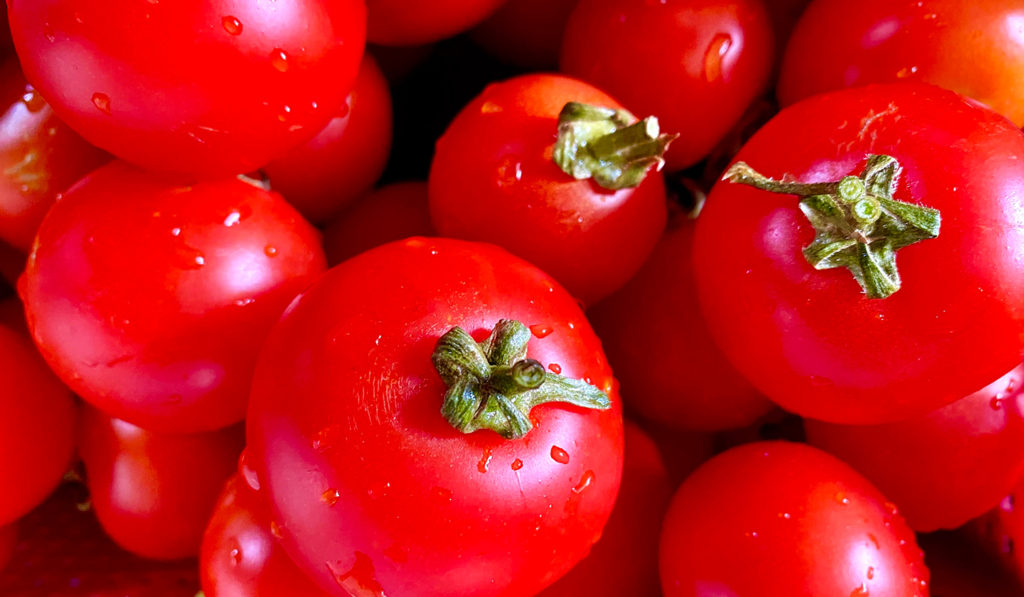

beyond the basics
-
soil & potting
Cucumbers need warm soil to germinate. Find a spot with good light and well–draining soil. Plant seeds in mounds about 1 inch deep. Give that little seed or container seedling lots of space, once they get growing, their vines really spread out to boost growth, feed the soil with dolomite lime, compost or Miracle-Gro® Shake ‘n Feed Tomato, Fruit & Vegetable Plant Food.
-
companion planting
Cucumbers work well beside asparagus, beans, Brassicas, celery, corn, dill, kohlrabi, lettuce, onion, peas, radish, and tomatoes. Avoid potatoes and sage. Sunflowers and cornflowers make a beautiful natural trellis for cucumber vines to climb. Dill attracting beneficial predatory insects that eat pests. The nasturtium flower repels pests and is even thought to improve a cucumber’s taste.
-
harvesting
Harvest time! Your cucumbers should be uniformly green, firm, and have a slightly rounded tip. They grow rapidly, so check them often. Be sure you don’t miss any under the leaves. Once they become yellow, bulbous or soft, they’re overripe. A little early is better than too late.
-
pest control
What are these little white flies? They are literally Whiteflies. They drink sap and excrete a sticky ‘honeydew’ which also encourages mould. Use sticky traps or Ortho® Bug B Gon® ECO Insecticidal Soap to keep your cucumbers healthy. Another common pest is the cucumber beetle. These little guys can be found on your seedlings, just as they’re starting to grow up. If you don’t catch these beetles soon enough, their larvae will feed on the plant and kill it. Cucumber beetles also spread bacteria and viruses when they move from plant to plant. To get rid of these little pests, try using sticky traps. You could also knock the beetles off your plant and catch them in a little piece of cardboard or a small jug.
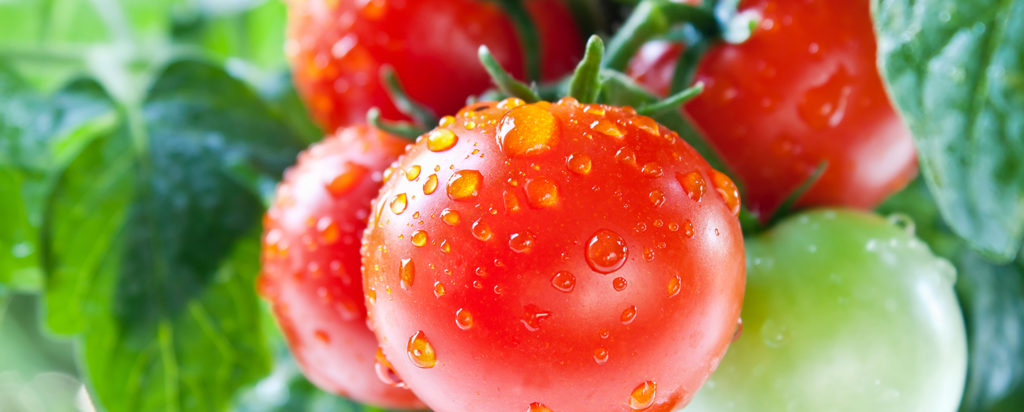
troubleshooting
-
what ate my stems right near the soil level?
Probably Cutworms. Check the soil for gray grubs about 1/2 inch (1 cm). They love to eat stems, roots, and leaves. Protect your vines with a 3 inch paper collar around the base. You can also sprinkle wood ash around the base. It helps to keep your garden weed free.
-
drooping or wilting leaves?
Needs water. Does your Pothos look wilted and droopy? Do those normally perky heart-shaeped leaves feel thinner? Your poor Pothos is crying out for a drink. Instead of doing one giant dump of water, water a little once per day for three days. You want the soil pleasantly moist, not super soggy. Your Pothos should bounce back in just a few days.
-
why do I have deformed or yellow leaves?
Likely Aphids. Look for teeny-tiny oval, and yellowish– green pear-shaped insects, clustering under the leaves. They excrete a sticky waste called honeydew (far too pleasant a name) which turns into black powdery mold. Treat with insecticidal soap.
-
why are my smaller plants turning yellow?
Sounds like Southern corn rootworm. They’re the larval form of the spotted cucumber beetle. Turn over the soil in your garden to interrupt this pest’s destructive life cycle.
-
what’s this white, powdery stuff?
It’s a fungus called Powdery Mildew. It forms white spots on the leaves or even the stems. Left un-checked it can turn the leaves yellow or even brown. Lack of airflow is the cause, so do what you can to clear around your plants. Remove infected leaves. To fight the mildew, your garden centre will have a spray containing sulfur.
-
no fruit coming through?
It’s a plant sex thing. A cucumber’s first flowers are male, followed by female flowers. Only the female flowers produce cucumbers, so you may just need to wait a bit, until the female flowers get pollinated. If there aren’t enough pollinators (like bees) in your area, you can plant flowers in your garden to attract them. Or, be the bee! Pick some male flowers and dust their pollen on the female flowers.

cucumbers
aka Cucumis Sativus
Crunch! Cucumbers are delicious in salads, and the perfect gateway to your new obsession with pickling. Their vines want to run wild, but they are trainable.
variations
Armenian Cucumber, English Cucumbers, Lemon Cucumbers and Persian Cucumbers, and almost 100 more varieties!
light
full sun
Cucumbers like about 8 hours of sunlight a day.
water + feeding
thirsty friends
The thirsty vines of the Cucumber need at least 1 inch of water per week. And if your cucumbers are out in full sun, get ready to water a lot!
toxic
non-toxic
Cucumbers are non-toxic and even make delicious, hydrating snacks for cats and dogs.
size
medium
Smaller cucumber varieties are best grown to about 4 inches (10 cm). Longer varieties like English cucumbers can grow 6 to 8 inches (15–20cm). General rule, smaller is better. Don’t let them overgrow or they may get soft and bitter.
pro tip
oh shoot!
When a vine has grown 7 leaves, pinch off the growing tip. The vine should develop side shoots that you can leave on the ground, or train up a trellis or netting.
fun fact
super hydrater
Raw cucumbers are 95% water! They’re also 100% delicious.
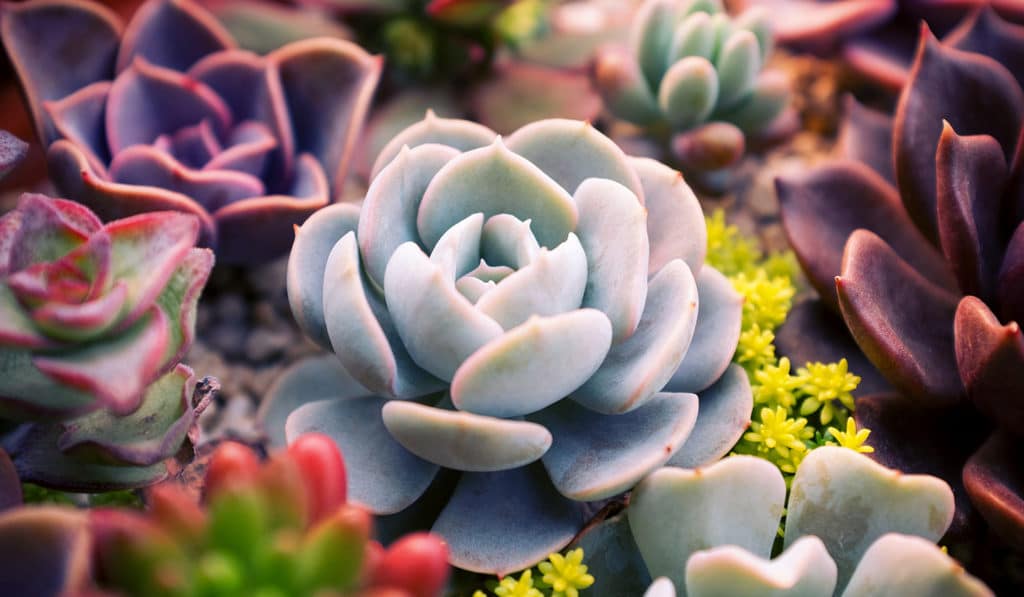
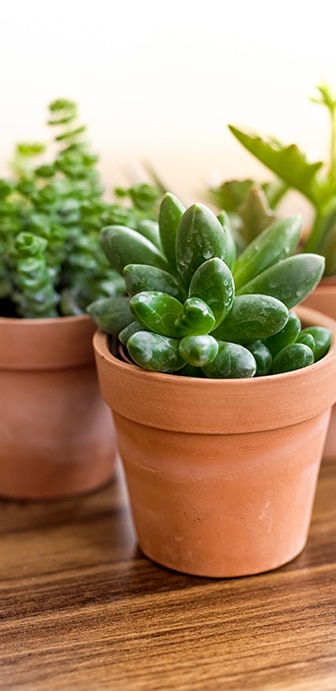
beyond the basics
-
soil & potting
These desert dwellers prefer a light, well-draining potting soil like Miracle-Gro Cactus, Palm and Succulent Potting Mix. Or, use regular potting soil and add some potting sand or perlite. A layer of sand on the top will help prevent rot. Ensure the pot has good drainage and aloe should never sit in water. Empty drainage trays if you see water collecting.
-
when to repot
Repot every 1 to 2 years in the Spring, especially with younger plants. Increase pot diameter by 2 inches every time. Want them to stay cute and little? You can stunt the growth by root trimming. In later years you can replace the top couple inches of soil instead of completely repotting.
-
propagation
Making new succulent plant babies is easy. In fact many propagate on their own. You will notice little mini versions starting grow. These “pups” can be gently separated potted as a new plant. If you’re not getting pups, remove a leaf, let it dry for a couple of days and place it on some moist soil. It should sprout roots, and voila! You have an ultra mini plant.
-
pest control
Succulents don’t typically suffer from pests, but they can sometimes get bugs. Gnats are most likely. Inspect those juicy little leaves regularly. Check out our Pest control section in Plant 101 for how to identify and deal with pests on your plant!
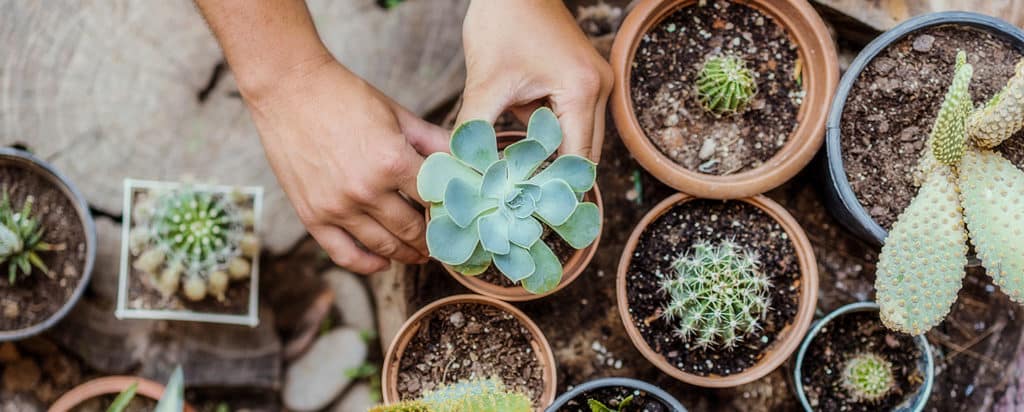
troubleshooting
-
why are the eaves turning brown, red or reddish brown?
A couple of possibilities. Maybe too much direct summer sun. Or possibly overwatering or root damage. First, moving your plant to a still-bright but less sun-blasted spot. Reduce the watering and follow our watering instructions above. If your succulent buddy still doesn’t bounce back, check for root damage.
-
what’s causing these dark spots? brown or mushy leaves?
Almost certainly too much water. This problem is no big deal if you catch it early. First, stop watering! Let’s dry out that soil. Check your pot’s drainage. Does it have a hole that allows excess water to escape? Help things dry by poking holes in the soil. This will get oxygen to the roots. You can also put the pot (with drainage holes) in a tray that’s lined with a layer of dry soil. It acts like a sponge to draw out extra moisture. Now, let’s check for root rot. Dig down and cut out any that look affected. If things are really bad, consider repotting entirely with new soil. Moving forward, water only when the soil is totally dry and make sure you water the soil, not the leaves. Water can collect between the leaves at its base, and start to rot. A thin layer of sand on top of the soil can reduce pooling water up top.
For more information check out our Plant 101 section.
-
pale or yellowing leaves?
Not enough light and/or overwatering. If the whole plant has yellowed or gone pale, it definitely needs more light. Move your friend to a brighter spot and resist the urge to overwater. Let the top two inches of soil get dry before watering again.
-
ew, what’s with the shrunken, wrinkled leaves?
Your plant needs a drink. Underwatering a succulent is hard to do, but it does happen. Give small amounts of water for three days in a row. Make sure you do this at soil level, not poured on the leaves. This is the ONE TIME it’s okay to do a little misting. A little does a lot. Resist the urge to water all at once! Your friend will plump up in a few days.
-
why isn’t my succulent growing?
Not enough light. It takes a lot of bright (mostly indirect) light to get succulents growing. If you’re not noticing any growth, or the new growth looks pale, it’s time to move to brighter spot. You may need slightly more frequent watering after the move. Note, succulents grow in slow motion at the best of times, so a little patience goes a long way.

cucumbers
aka Cucumis Sativus
Crunch! Cucumbers are delicious in salads, and the perfect gateway to your new obsession with pickling. Their vines want to run wild, but they are trainable.
variations
Armenian Cucumber, English Cucumbers, Lemon Cucumbers and Persian Cucumbers, and almost 100 more varieties!
light
full sun
Cucumbers like about 8 hours of sunlight a day.
water + feeding
thirsty friends
The thirsty vines of the Cucumber need at least 1 inch of water per week. And if your cucumbers are out in full sun, get ready to water a lot!
toxic
non-toxic
Cucumbers are non-toxic and even make delicious, hydrating snacks for cats and dogs.
size
medium
Smaller cucumber varieties are best grown to about 4 inches (10 cm). Longer varieties like English cucumbers can grow 6 to 8 inches (15–20cm). General rule, smaller is better. Don’t let them overgrow or they may get soft and bitter.
pro tip
oh shoot!
When a vine has grown 7 leaves, pinch off the growing tip. The vine should develop side shoots that you can leave on the ground, or train up a trellis or netting.
fun fact
super hydrater
Raw cucumbers are 95% water! They’re also 100% delicious.
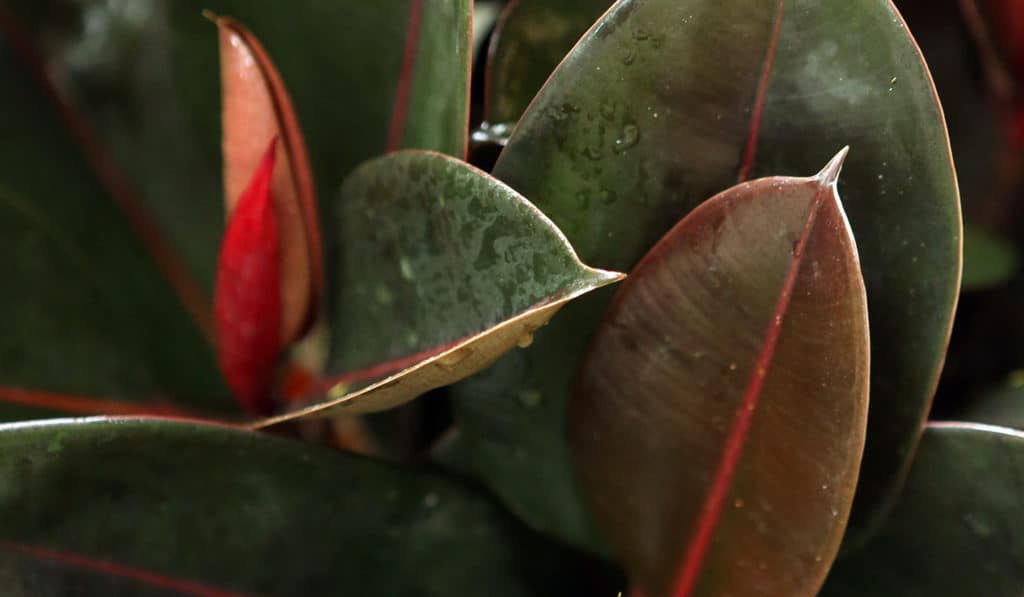
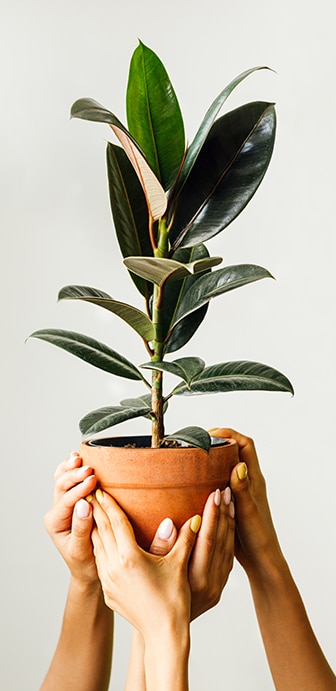
beyond the basics
-
soil & potting
Use a rich, well-draining, indoor potting soil, like Miracle-Gro® Indoor Potting Mix. Ensure your pot has good drainage. Don’t let it sit in water and if you notice water pooling in the drainage tray, empty it.
-
when to repot
Repot every 1 to 2 years in the Spring, especially with younger plants. Increase pot by 2 inches every time. When your Rubber plant is older and becomes a big fella, repotting gets hard! So you can just replace the top few inches of soil.
-
propagation
Be careful what you start, because these plants get big! Pick a stem showing thick, healthy leaves and cut halfway up the stem. Milky sap will come out, and it’s an irritant you want to avoid. Remove the bottom leaves to give yourself a nice stretch of stem. It’s not the easiest propagator, so you’ll need rooting hormone to encourage roots. Dip your stem in the hormone and pot it moist soil, like Miracle-Gro® Indoor Potting Mix.
-
pest control
Look for mealybugs, scale insects, and spider mites. During your regular leaf cleaning, inspect the underside of each leaf. Check out our Pest control section in Plant 101 for how to identify and deal with pests on your plant!
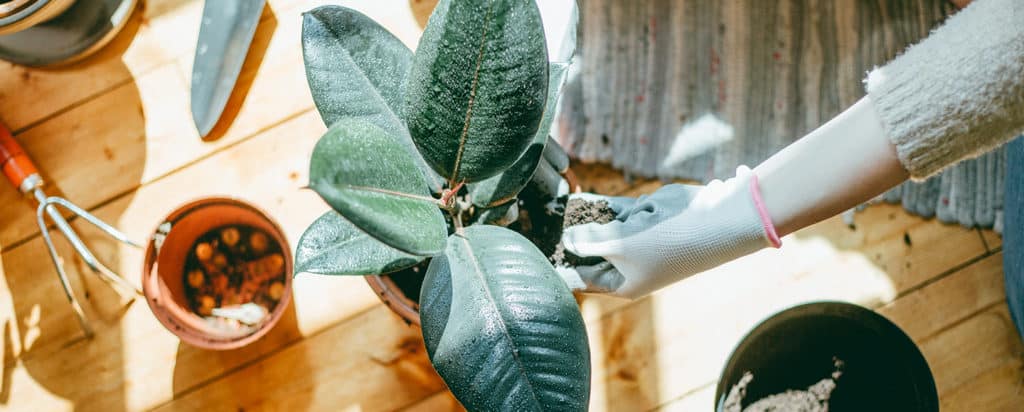
troubleshooting
-
why are there patchy, pale spots on leaves?
Too much direct sunlight. Rubber plants don’t like direct sun. It’s too hot on those big, broad leave, and they’ll lose moisture, causing these patchy pale spots. Shade the window or move your plant away from this direct sun. Sadly, the spots don’t heal, so consider removing the most damaged ones.
-
what’s with all the dropping leaves?
Rubber plants get stressed out easily. Any sudden change is likely to trigger leaf drop. Blasts of air conditioning or furnace heat. Cold drafts under a door. Being taken home from the nursery is also a big change in your plant’s life! Expect droppage. If you have not moved it recently and you can’t source any sudden temp changes then it could be overly dry air, or under watering and feeding. Review your care routine and your Rubber plant should… bounce back.
-
why are there dark Patches or spots on leaves?
Possible sunburn, or worse, leaf spot. If your Rubber plant is sitting in direct sunlight, it’s probably sunburn. Especially if it’s getting hot Summer sun. Move to still-bright indirect spot. If it’s not sunburn, it could be leaf spot, a fungal disease. Overwatering, especially in the winter, is usually the cause. First, avoid spreading to other plants by separating them physically. Remove all spotty leaves and check for plant debris in the pot. If you’re misting, stop. You want the leaves to get dry. Treat with fungicide.
-
why do I have yellowing, wilting leaves?
Probably root rot from overwatering. Do you also notice mushy stems and/or slower growth? These are all signs of root rot. Not to worry, when caught early this is easily fixable. Reduce watering and ensure the soil dries out before watering. Check your pot’s drainage. Does it have a hole that allows excess water to escape? Help things dry by poking holes in the soil. This will get oxygen to the roots. You can also put the pot (with drainage holes) in a tray that’s lined with a layer of dry soil. It acts like a sponge to draw out extra moisture. Now, let’s check for root rot. Dig down and cut out any that look affected. If things are really bad, consider repotting entirely with new soil. For more information check out our Plant 101 section.

cucumbers
aka Cucumis Sativus
Crunch! Cucumbers are delicious in salads, and the perfect gateway to your new obsession with pickling. Their vines want to run wild, but they are trainable.
variations
Armenian Cucumber, English Cucumbers, Lemon Cucumbers and Persian Cucumbers, and almost 100 more varieties!
light
full sun
Cucumbers like about 8 hours of sunlight a day.
water + feeding
thirsty friends
The thirsty vines of the Cucumber need at least 1 inch of water per week. And if your cucumbers are out in full sun, get ready to water a lot!
toxic
non-toxic
Cucumbers are non-toxic and even make delicious, hydrating snacks for cats and dogs.
size
medium
Smaller cucumber varieties are best grown to about 4 inches (10 cm). Longer varieties like English cucumbers can grow 6 to 8 inches (15–20cm). General rule, smaller is better. Don’t let them overgrow or they may get soft and bitter.
pro tip
oh shoot!
When a vine has grown 7 leaves, pinch off the growing tip. The vine should develop side shoots that you can leave on the ground, or train up a trellis or netting.
fun fact
super hydrater
Raw cucumbers are 95% water! They’re also 100% delicious.
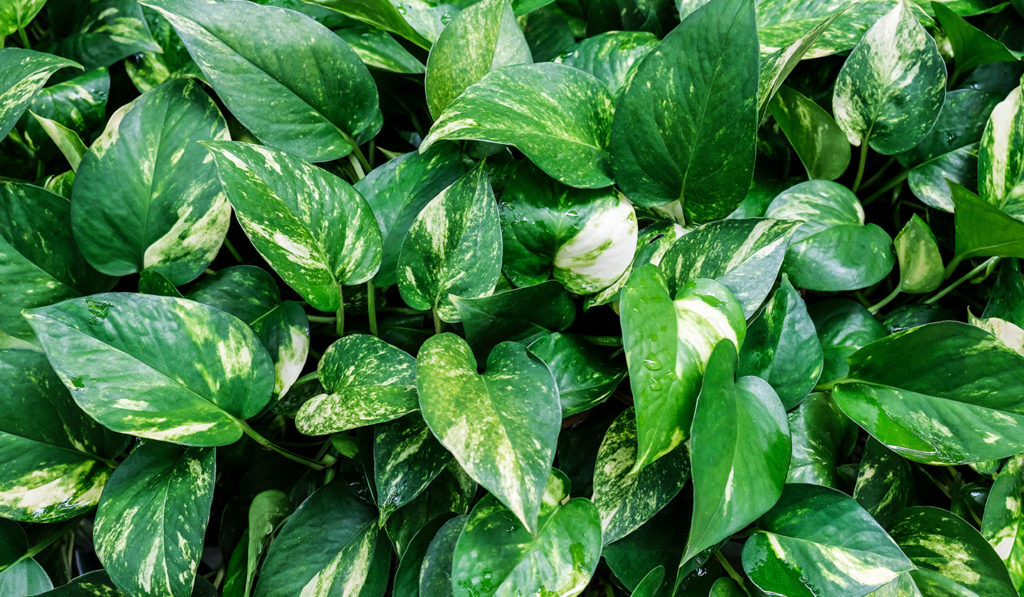

beyond the basics
-
soil & potting
Cucumbers need warm soil to germinate. Find a spot with good light and well–draining soil. Plant seeds in mounds about 1 inch deep. Give that little seed or container seedling lots of space, once they get growing, their vines really spread out to boost growth, feed the soil with dolomite lime, compost or Miracle-Gro® Shake ‘n Feed Tomato, Fruit & Vegetable Plant Food.
-
companion planting
Cucumbers work well beside asparagus, beans, Brassicas, celery, corn, dill, kohlrabi, lettuce, onion, peas, radish, and tomatoes. Avoid potatoes and sage. Sunflowers and cornflowers make a beautiful natural trellis for cucumber vines to climb. Dill attracting beneficial predatory insects that eat pests. The nasturtium flower repels pests and is even thought to improve a cucumber’s taste.
-
harvesting
Harvest time! Your cucumbers should be uniformly green, firm, and have a slightly rounded tip. They grow rapidly, so check them often. Be sure you don’t miss any under the leaves. Once they become yellow, bulbous or soft, they’re overripe. A little early is better than too late.
-
pest control
What are these little white flies? They are literally Whiteflies. They drink sap and excrete a sticky ‘honeydew’ which also encourages mould. Use sticky traps or Ortho® Bug B Gon® ECO Insecticidal Soap to keep your cucumbers healthy. Another common pest is the cucumber beetle. These little guys can be found on your seedlings, just as they’re starting to grow up. If you don’t catch these beetles soon enough, their larvae will feed on the plant and kill it. Cucumber beetles also spread bacteria and viruses when they move from plant to plant. To get rid of these little pests, try using sticky traps. You could also knock the beetles off your plant and catch them in a little piece of cardboard or a small jug.
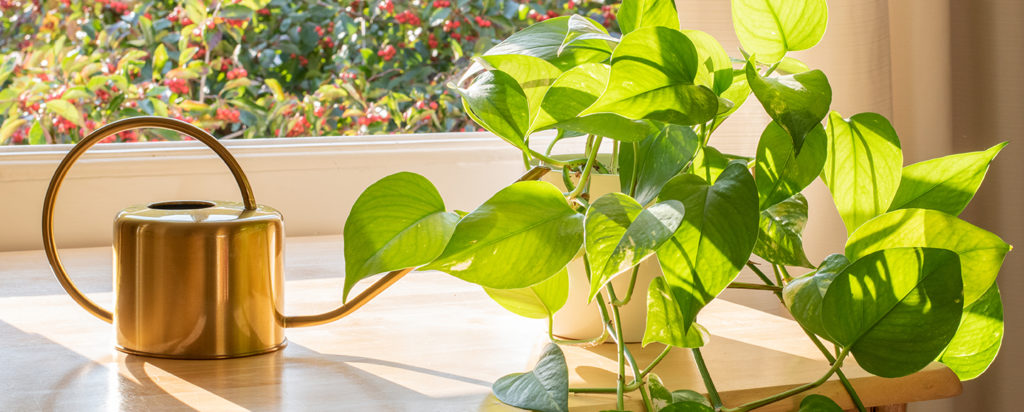
troubleshooting
-
what ate my stems right near the soil level?
Probably Cutworms. Check the soil for gray grubs about 1/2 inch (1 cm). They love to eat stems, roots, and leaves. Protect your vines with a 3 inch paper collar around the base. You can also sprinkle wood ash around the base. It helps to keep your garden weed free.
-
drooping or wilting leaves?
Needs water. Does your Pothos look wilted and droopy? Do those normally perky heart-shaeped leaves feel thinner? Your poor Pothos is crying out for a drink. Instead of doing one giant dump of water, water a little once per day for three days. You want the soil pleasantly moist, not super soggy. Your Pothos should bounce back in just a few days.
-
why do I have deformed or yellow leaves?
Likely Aphids. Look for teeny-tiny oval, and yellowish– green pear-shaped insects, clustering under the leaves. They excrete a sticky waste called honeydew (far too pleasant a name) which turns into black powdery mold. Treat with insecticidal soap.
-
why are my smaller plants turning yellow?
Sounds like Southern corn rootworm. They’re the larval form of the spotted cucumber beetle. Turn over the soil in your garden to interrupt this pest’s destructive life cycle.
-
what’s this white, powdery stuff?
It’s a fungus called Powdery Mildew. It forms white spots on the leaves or even the stems. Left un-checked it can turn the leaves yellow or even brown. Lack of airflow is the cause, so do what you can to clear around your plants. Remove infected leaves. To fight the mildew, your garden centre will have a spray containing sulfur.
-
no fruit coming through?
It’s a plant sex thing. A cucumber’s first flowers are male, followed by female flowers. Only the female flowers produce cucumbers, so you may just need to wait a bit, until the female flowers get pollinated. If there aren’t enough pollinators (like bees) in your area, you can plant flowers in your garden to attract them. Or, be the bee! Pick some male flowers and dust their pollen on the female flowers.

cucumbers
aka Cucumis Sativus
Crunch! Cucumbers are delicious in salads, and the perfect gateway to your new obsession with pickling. Their vines want to run wild, but they are trainable.
variations
Armenian Cucumber, English Cucumbers, Lemon Cucumbers and Persian Cucumbers, and almost 100 more varieties!
light
full sun
Cucumbers like about 8 hours of sunlight a day.
water + feeding
thirsty friends
The thirsty vines of the Cucumber need at least 1 inch of water per week. And if your cucumbers are out in full sun, get ready to water a lot!
toxic
non-toxic
Cucumbers are non-toxic and even make delicious, hydrating snacks for cats and dogs.
size
medium
Smaller cucumber varieties are best grown to about 4 inches (10 cm). Longer varieties like English cucumbers can grow 6 to 8 inches (15–20cm). General rule, smaller is better. Don’t let them overgrow or they may get soft and bitter.
pro tip
oh shoot!
When a vine has grown 7 leaves, pinch off the growing tip. The vine should develop side shoots that you can leave on the ground, or train up a trellis or netting.
fun fact
super hydrater
Raw cucumbers are 95% water! They’re also 100% delicious.
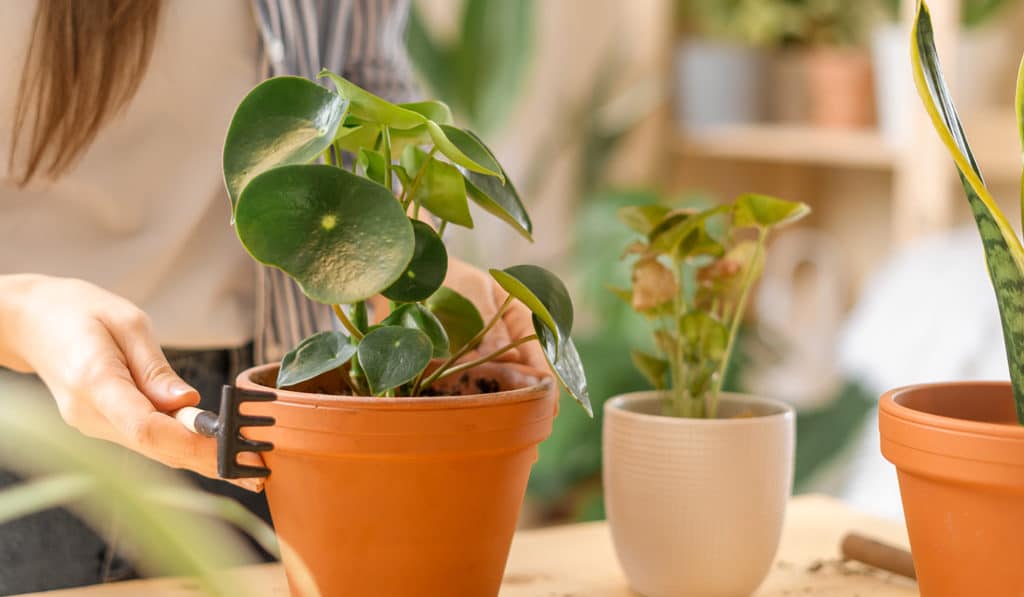
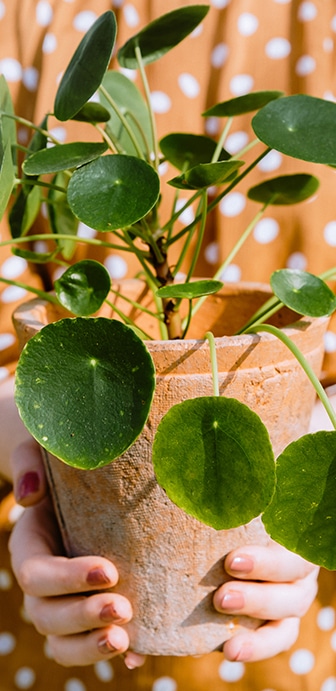
beyond the basics
-
soil & potting
This plant likes a light, well-draining soil like Miracle-Gro Cactus, Palm and Succulent Potting Mix. Or add some potting sand or perlite to regular potting soil. Your pot must have good drainage and don’t let Pilea sit in water. If you see water collecting in the drainage tray, dump it.
-
when to repot
Repot every 1 to 2 years in the Spring, especially with younger plants. Increase pot by 2 inches every time. If dealing with a more mature, fully grown plant you can just replace the top few inches of soil.
-
propagation
So easy, because Pilea is self-propagating. It creates tiny offshoots also known as ‘pups’. You can leave them on the plant, or create a new one. Wait until your Pilea pup is at least a few inches tall. Gently dig under the pup and cut (or gently pull) the plant free, ensuring you get roots. Put the pup in some water to grow stronger roots, or plant directly in soil. You have a new mini Pilea that makes a perfect gift!
-
pest control
Pileas are bug resistant, but pests are still possible. Inspect under the leaves when doing your regular dusting & cleaning. Check out our Pest control section in Plant 101 for how to identify and deal with pests on your plant!
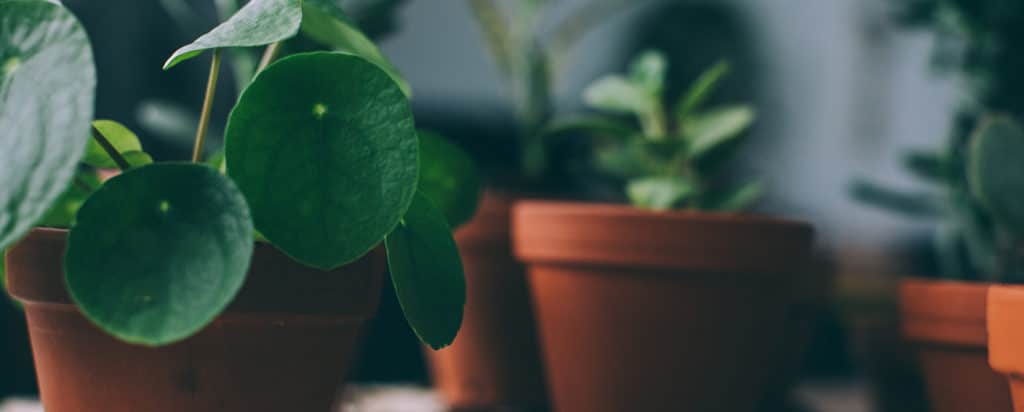
troubleshooting
-
leaves curved in, or out?
Light and water are incorrect. If the leaves are curled inwards, your Pilea is probably dehydrated. It’s not getting enough water, or it’s getting too much sun. On the flipside, If the leaves are curled outwards it’s probably too much water or not enough light. Check your soil before watering and ensure the top two inches of soil are dry before watering. Time between watering varies by plant and how much light they’re getting.
-
leaves turning yellow or dropping off?
Where are they yellowing? If only the bottom leaves are yellowing and dropping, there’s no problem. That’s normal Pilea behaviour. But If the whole plant is yellowing, you’re probably overwatering. When doing your watering routine, make sure the top 1 to 2 inches of soil are dry before watering.
-
leaves facing in one direction?
Rotate your plant! Pilea’s love to grow towards the sun. This can cause them to become one side heavy or grow unevenly. You should remember to turn your plant every time you water to allow the plant to grow evenly.
-
mold on the surface soil?
Overwatering, too little time between watering. Mold (and even mushrooms) growing on your soil is not a direct threat. But it IS a sign of overwatering. Root rot can follow if not addressed. Water less frequently and make sure you let the top two inches of soil fully dry before watering. Ensure you have proper drainage. If things look really moldy, you can remove the top inch or so of soil.
-
powdery, white patches on leaves?
Powdery mildew. Like mold, this isn’t dangerous, but it makes your precious Pilea less pretty! So it’s got to go. Bad air circulation is usually the cause. Remove affected leaves and move your plant somewhere with better air circulation.

cucumbers
aka Cucumis Sativus
Crunch! Cucumbers are delicious in salads, and the perfect gateway to your new obsession with pickling. Their vines want to run wild, but they are trainable.
variations
Armenian Cucumber, English Cucumbers, Lemon Cucumbers and Persian Cucumbers, and almost 100 more varieties!
light
full sun
Cucumbers like about 8 hours of sunlight a day.
water + feeding
thirsty friends
The thirsty vines of the Cucumber need at least 1 inch of water per week. And if your cucumbers are out in full sun, get ready to water a lot!
toxic
non-toxic
Cucumbers are non-toxic and even make delicious, hydrating snacks for cats and dogs.
size
medium
Smaller cucumber varieties are best grown to about 4 inches (10 cm). Longer varieties like English cucumbers can grow 6 to 8 inches (15–20cm). General rule, smaller is better. Don’t let them overgrow or they may get soft and bitter.
pro tip
oh shoot!
When a vine has grown 7 leaves, pinch off the growing tip. The vine should develop side shoots that you can leave on the ground, or train up a trellis or netting.
fun fact
super hydrater
Raw cucumbers are 95% water! They’re also 100% delicious.
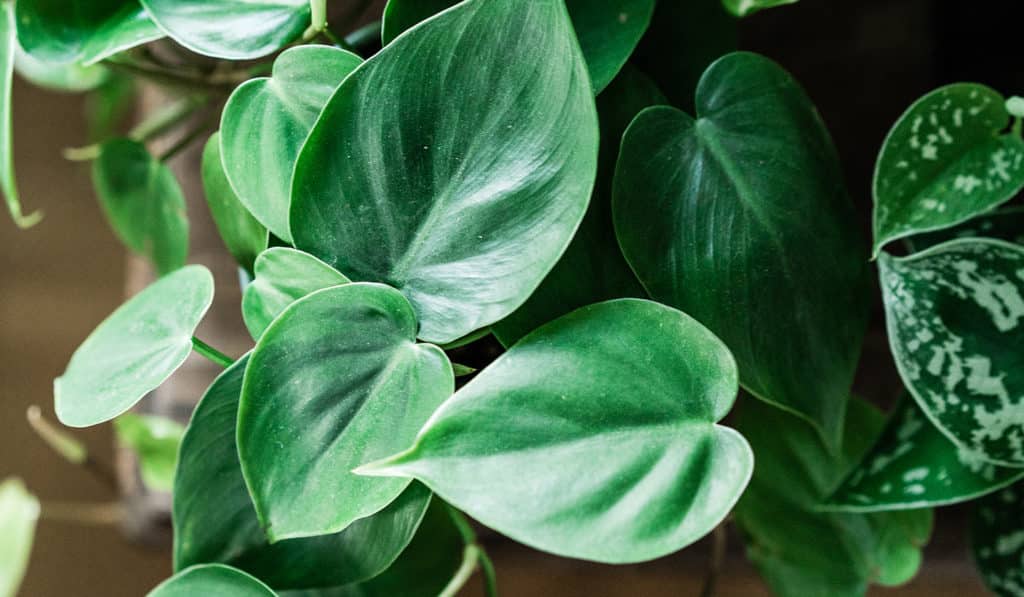
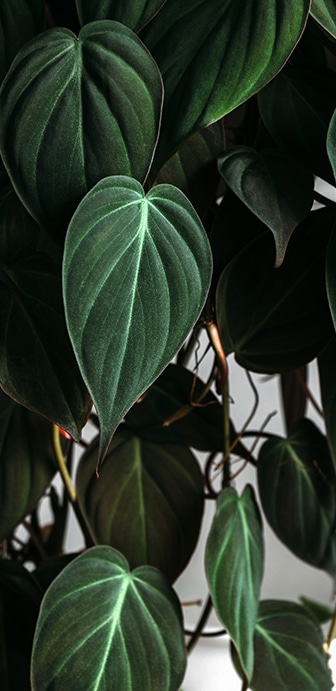
beyond the basics
-
soil & potting
Use a rich, well-draining, indoor potting soil, like Miracle-Gro® Indoor Potting Mix. Ensure your pot has good drainage. If you notice water pooling in the drainage tray, empty it.
-
when to repot
Repot every 2 years in the spring, especially with younger plants. Increase pot by 2 inches every time. If dealing with a more mature, fully grown plant you can just replace the top few inches of soil.
-
propogation
If you have a node or aerial root this plant is very easy to propagate. Cut just below the node and remove the lower leaves. Put in water and watch the roots grow in just a few short weeks! For more information on propagation check out our propagation project page!
-
pest control
Prone to mealybugs. Check the underside of leaves regularly when cleaning. Check out our Pest control section in Plant 101 for how to identify and deal with pests on your plant!
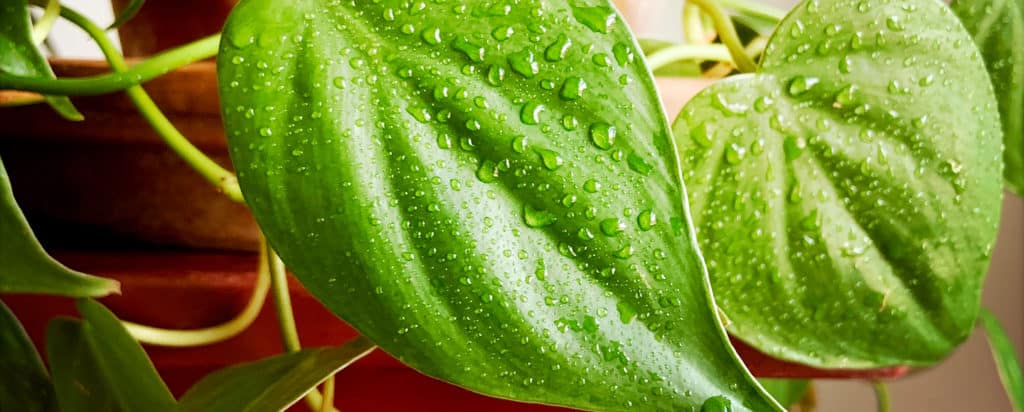
troubleshooting
-
yellowing lower leaves?
Low temperatures or drafts are probably the cause. Try moving your plant to a new location where it is clear of any drafts. Philodendrons like it warm, between 60 and 75 F (16 and 24C) It could also be underwatering or under fertilizing. Ensure you’re watering regularly when the top inch of soil becomes dry.
-
leaves dropping?
Probably a cold draft. Move to warm location that’s clear of any drafty windows or the air conditioning vent. It’s a hardy plant but still likes temps between 60 and 75 F (16 and 24C)
-
brown edges on the leaves?
Various. The soil could be too dry. Water regularly when the top inch of soil gets dry. Water until the soil is moist, but not soggy. If the air feels dry and the temp is over 75F (24C,) mist the leaves regularly. Consider a humidifier, or put the pot on a pebble-filled tray of water (making sure the pot is not touching the water). Philodendrons don’t like cold drafts, so this could also be the problem. Move away from cold windows or AC vents.
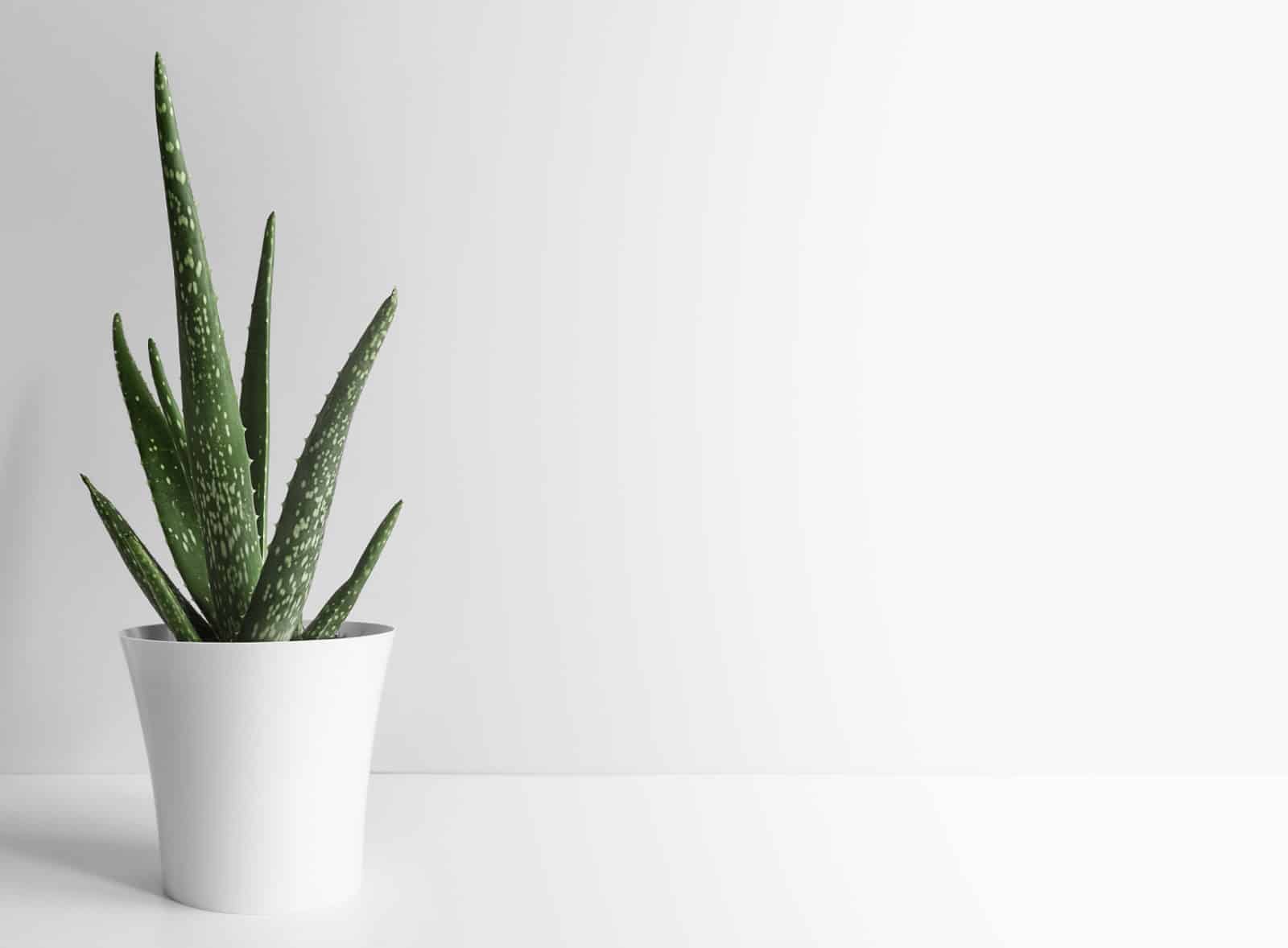
aloe vera
aka aloe barbadensis
Say “Ola” to this easy to grow succulent. Often touted as a “miracle” plant for its skin soothing gel, but the real miracle is how cute they look. An all-around great plant for rookies and exerts alike. Description: easy to grow succulent / soothes burns and skin irritations / southeast Arabian Peninsula / tropical
variations
Aloe Vera has a whopping 250 varieties. So many wonderful little differences to mix and match.
light
bright, indirect light
Find a spot with plenty of indirect light, and ideally a few hours of direct light.
water + feeding
allow to mostly dry out between watering
The top inch should be dry before watering again. Don’t overwater! It’s a desert plant. Feed once in spring, and once in summer.
toxic
safe on skin post likely toxic to ingest
Aloe gel is safe and soothing on the skin. You can even eat some varieties, but note! Most can cause indigestion, vomiting and airway irritation if eaten. Unless you’re 100% sure, keep away from kids and pets.
location
adaptable
Comfy with average indoor temperatures. Prefers things on the warmer side and doesn’t like drafts.
humidity
not an issue
Appreciates an occasional misting to control dust. Humidity levels aren’t a concern for this hearty little fella.
size
small to medium
Usually bought small and can to about 2 feet.
pro tip
water at soil level
Aloe doesn’t like water pooling in the creases between its leaves. That can cause leaf rot.
fun fact
it’s a super soother
Those thick, juicy leaves contain a soothing green gel that can be applied directly to burns (especially sun burns) and bug bites. External use only! It’s toxic to ingest.
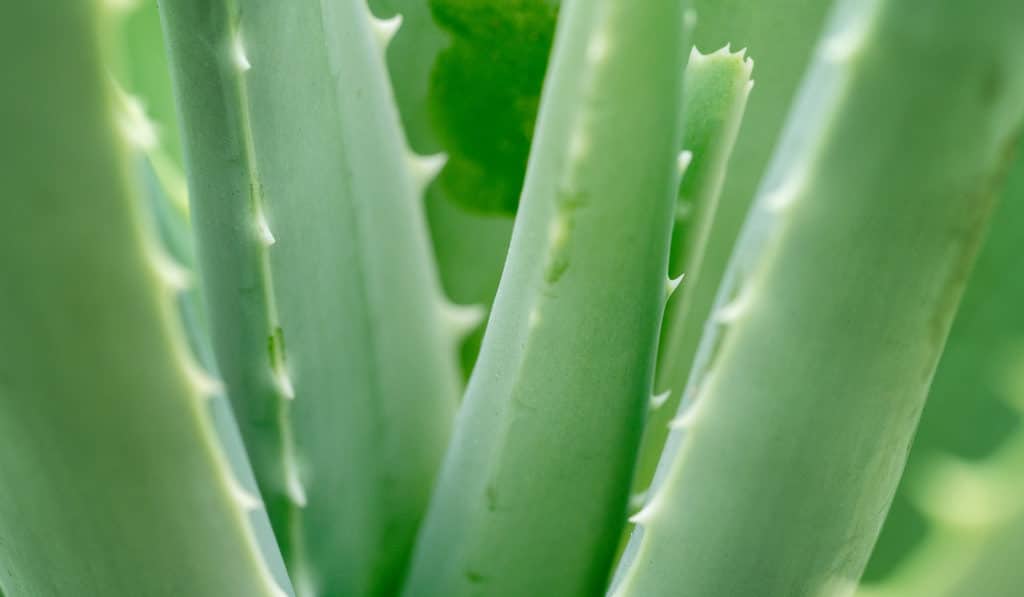
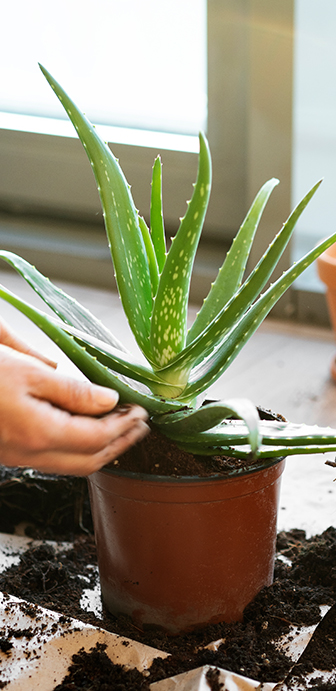
beyond the basics
-
soil & potting
Use a light, well-draining potting soil like Miracle-Gro Cactus, Palm and Succulent Potting Mix. Or, use regular potting soil and add some potting sand or perlite. A layer of sand on the top will help prevent rot. Ensure the pot has good drainage and aloe should never sit in water. Empty drainage trays if you see water collecting.
-
when to repot
Every 3-4 years in the spring. Especially when they’re small and growing. Increase pot diameter by 2 inches each time, and refresh the top few inches of soil. Growing too fast? You can slow the growth by trimming the roots.
-
propagation
Aloe self-propagates. It will make baby offshoots (also called ‘pups’). Leave pups on the main plant or, pot as a separate plant! Wait until the pup is at least 2” tall, then dig under the pup and find the roots at the base. Gently tug or trim the roots, they are key to the pup’s survival. You now have a new plant baby! See Soil + Potting above for planting instructions.
-
pest control
Aloe is prone to scale insects on the leaves. See our Pest control section in Plant 101 for how to identify and deal with pests on your plant!
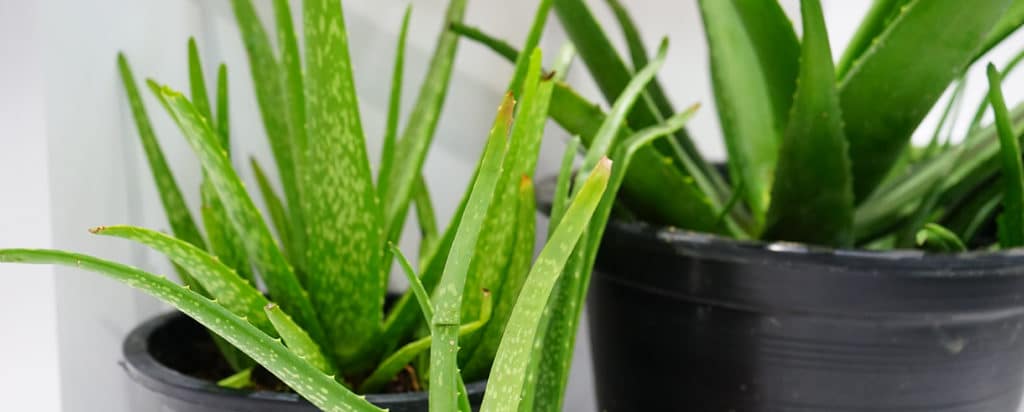
troubleshooting
-
leaves turning brown, red or reddish brown?
Variety of reasons. It could be too much summer sun, overwatering, or roots damage.
First, try moving your plant to a spot with less direct sunlight (but still bright). Reduce watering. If your little aloe buddy doesn’t recover check the roots for damage.
-
dark spots? brown or mushy leaves?
Probably overwatering. Caught early, this problem is easily corrected. Water at soil level and avoid spilling water on the leaves, cuz the pooling water can cause rot. Two inches of sand on top of the soil will help with drainage. Reduce watering and allow plant to dry out completely between watering. Ensure your pot has a drainage hole to let excess water out.
Other tricks: Poke holes in soil to get oxygen to the roots. Put a damp pot (with drainage holes) in a tray or dry soil, to suck up that extra moisture. Check the roots and remove any that have root rot. Consider repotting with new soil if things are a damp mess. For more information check out our Plant 101 section.
-
pale or yellowing leaves?
Overwatering or not enough light. Is the entire plant turning pale or yellow? It needs more light. Move to a brighter spot, watch out for soil dampness and avoid over watering.
-
shrunken, wrinkled leaves?
Your plant needs a drink. But don’t overdo it! Give it a small amount and also mist the leaves. Do this three days in a row. The leaves should rebound, getting nice and plump.
-
aloe not growing?
Not enough light. If your aloe isn’t growing, or the new growth is pale in colour, it’s crying out for more light. Most houseplants don’t like direct sun, but this desert-born baby likes it! A little direct sun every day is good, especially in darker winter months. Find a brighter spot and get growing.

cucumbers
aka Cucumis Sativus
Crunch! Cucumbers are delicious in salads, and the perfect gateway to your new obsession with pickling. Their vines want to run wild, but they are trainable.
variations
Armenian Cucumber, English Cucumbers, Lemon Cucumbers and Persian Cucumbers, and almost 100 more varieties!
light
full sun
Cucumbers like about 8 hours of sunlight a day.
water + feeding
thirsty friends
The thirsty vines of the Cucumber need at least 1 inch of water per week. And if your cucumbers are out in full sun, get ready to water a lot!
toxic
non-toxic
Cucumbers are non-toxic and even make delicious, hydrating snacks for cats and dogs.
size
medium
Smaller cucumber varieties are best grown to about 4 inches (10 cm). Longer varieties like English cucumbers can grow 6 to 8 inches (15–20cm). General rule, smaller is better. Don’t let them overgrow or they may get soft and bitter.
pro tip
oh shoot!
When a vine has grown 7 leaves, pinch off the growing tip. The vine should develop side shoots that you can leave on the ground, or train up a trellis or netting.
fun fact
super hydrater
Raw cucumbers are 95% water! They’re also 100% delicious.
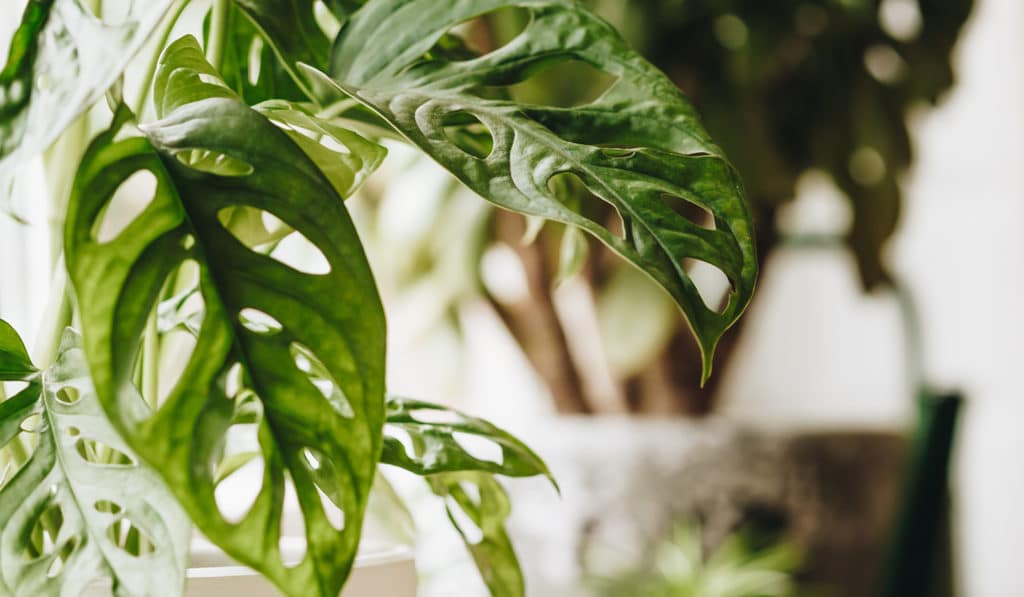
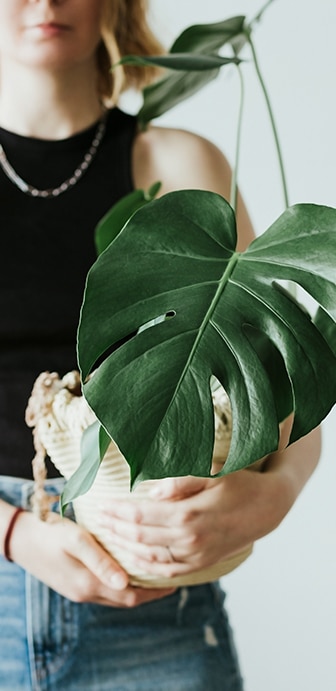
beyond the basics
-
soil & potting
Use a rich, well-draining, indoor potting soil, like Miracle-Gro® Indoor Potting Mix. Ensure your pot has good drainage. If you notice water pooling in the drainage tray, empty it.
-
when to repot
Monstera grows fast, filling the pot with roots, and can quickly become rootbound. Repot in the Spring every 1 to 2 years, especially with younger plants. Increase your pot by 2 inches. When your Monstera is more mature, you can get away with just replacing the top few inches of soil.
-
propagation
Monstera is easy to propagate, especially If you have a node or aerial roots. Make your cut just below the node , then remove the lower leaves. Place your cutting in a glass jar with water and roots will grow within a couple weeks. For more information on propagation check out our propagation project page!
-
pest control
The most common pest is mealybugs. Look under those leaves when doing your regular cleaning. Check out our Pest control section in Plant 101 for how to identify and deal with pests on your plant!
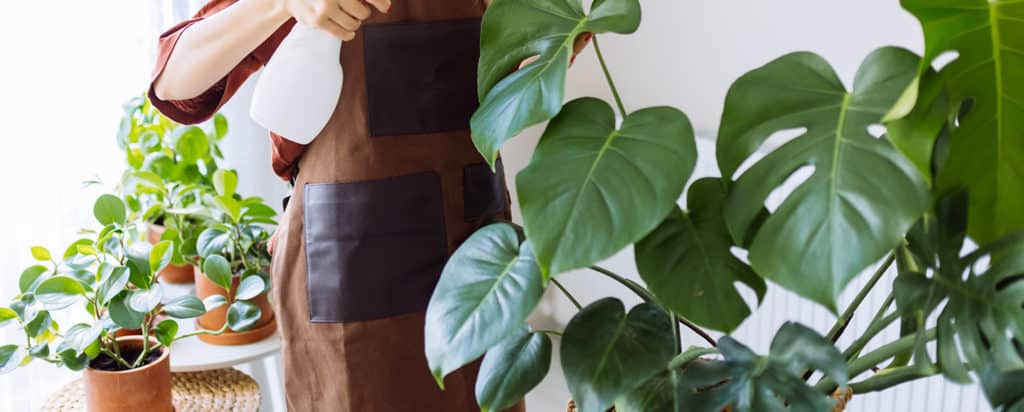
troubleshooting
-
yellow leaves?
You’re probably overwatering. Are the leaves are also wilting? It’s almost certainly too much water, but this problem is easy to solve if caught early. Let your Monstera dry out completely. Make sure your plant pot has a drainage hole to allow excess water to escape.
If you’ve caught it early you should be able to fix this rather easily. Try poking holes in soil to allow for oxygen to get to the roots, or place pot (with drainage holes) in a tray or container with dry soil. This will soak up excess moisture. Finally check for root rot, remove any roots that seem affected, you may want to repot with fresh dry soil. For more information check out our Plant 101 section.
-
leaf tips and edges turning brown?
Could be a variety of reasons. Dry air, dry potting mix, too low of temperatures, or outgrowing pot size. If the room this plant is in is over 75 F/24 C and the air feels dry try a humidifier or placing plant on a pebble filled try of water. Mist leaves regularly. If near a heat vent move it away. If the room is too cold, or near a cold window move somewhere warmer.
Check if roots are bound or sneaking out the bottom drainage hole. Repot if necessary.
-
plant ‘crying’?
Too much water. Monstera leaves can drip if their potting mix is too wet. Slow down on the watering. Make sure the top two inches of potting mix get fully dry between waterings.
-
no holes in the leaves?
Probably not a problem! Young plants don’t have them. But if you have a mature plant that’s stopped producing holes with leaves, something is wrong. Check your location, watering and feeding routine.
-
mold on the surface soil?
Overwatering, too little time between watering. Mold (and even mushrooms) growing on your soil is not a direct threat. But it IS a sign of overwatering. Root rot can follow if not addressed. Water less frequently and make sure you let the top two inches of soil fully dry before watering. Ensure you have proper drainage. If things look really moldy, you can remove the top inch or so of soil.
